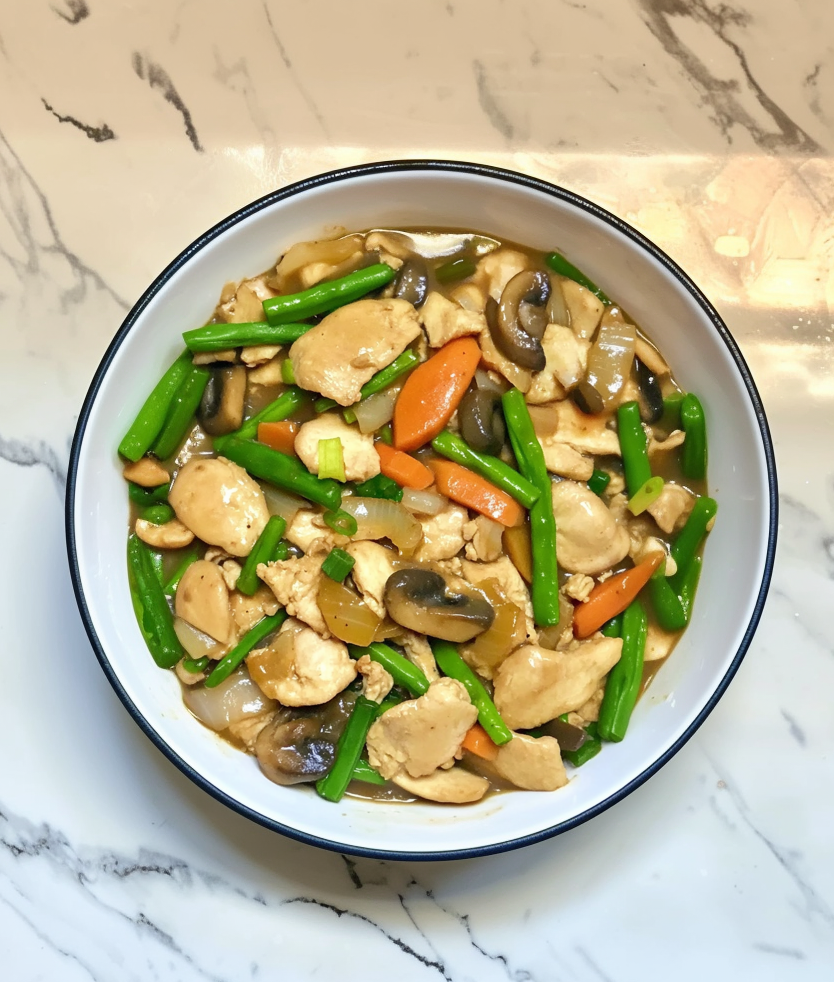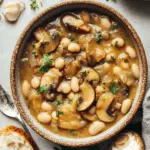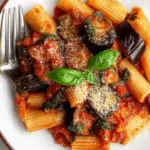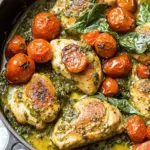Moo Goo Gai Pan is a classic Chinese-American stir-fry dish that combines tender slices of chicken with a medley of fresh vegetables in a savory sauce. Originating from the Cantonese dish “Mah Gu Gai Pin,” which translates to “mushrooms and sliced chicken,” this recipe has been adapted to suit Western palates while retaining its authentic essence. It’s a quick and flavorful meal that’s perfect for weeknight dinners, offering a healthy balance of protein and vegetables.
Full Recipe:
Ingredients
- 1 lb boneless, skinless chicken breast
- 2 tsp cornstarch
- 1 tsp soy sauce
- 1 tsp oyster sauce
- ½ Tbsp Chinese cooking wine (Shaoxing wine)
- ½ tsp baking soda
- ¼ tsp sesame oil
- 1 Tbsp oil (for stir-frying)
- 2 carrots, thinly sliced
- 1 cup mushrooms, sliced
- 2 green onions, chopped (white and green parts separated)
- 1 cup snow peas
- 1 can water chestnuts, drained
- 2 cloves garlic, minced
For the sauce:
- 2 Tbsp soy sauce
- 1 Tbsp oyster sauce
- 1 Tbsp Chinese cooking wine
- ½ cup chicken broth
- 1 tsp cornstarch mixed with 1 Tbsp water (slurry)
Directions
- Slice the chicken into ¼-inch slices against the grain. In a bowl, combine the chicken with cornstarch, soy sauce, oyster sauce, Chinese cooking wine, baking soda, and sesame oil. Let it marinate for 30 minutes.
- In a separate bowl, mix together soy sauce, oyster sauce, Chinese cooking wine, and chicken broth. Set aside.
- Heat oil in a wok or large skillet over medium-high heat. Add the marinated chicken slices and cook for 3-4 minutes until cooked through. Remove the chicken and set aside.
- In the same wok, add carrots, mushrooms, and the white parts of the green onions. Stir-fry for about 3 minutes. Add minced garlic and cook for another 30 seconds. Add water chestnuts and continue to stir-fry for 1 minute.
- Return the cooked chicken to the wok. Pour in the prepared sauce and bring to a simmer. Add the cornstarch slurry to thicken the sauce, stirring continuously. Add snow peas and cook for an additional minute until the sauce has thickened and the vegetables are tender-crisp.
- Garnish with the green parts of the green onions and serve immediately over steamed rice.
Nutritional Facts (Per Serving)
- Calories: Approximately 143 kcal
- Protein: 15 g
- Carbohydrates: 10 g
- Fat: 5.2 g
- Saturated Fat: 0.9 g
- Cholesterol: 37 mg
- Sodium: 426 mg
- Fiber: 2.6 g
- Sugar: 4.3 g
- Vitamin A: 21.6 mcg
- Vitamin C: 14.0 mg
- Calcium: 21.6 mg
- Iron: 1.04 mg
- Potassium: 426 mg
Historical Background and Cultural Significance
The origins of Moo Goo Gai Pan trace back to traditional Cantonese cooking, where dishes featuring mushrooms (“moo goo”) and chicken (“gai”) have been staples for centuries. Cantonese cuisine is known for its emphasis on fresh ingredients, light seasoning, and delicate flavors that bring out the natural taste of each component. Originally, the dish used fresh mushrooms and chicken sliced thinly, stir-fried to retain their textures and nutritional value.
With the immigration of Chinese communities to Western countries, many traditional recipes underwent adaptations to suit local tastes and ingredient availability. Moo Goo Gai Pan became a prominent feature on Chinese-American menus during the 20th century, especially post-World War II, when Chinese cuisine began gaining popularity in the United States. It represents a culinary bridge between authentic Cantonese flavors and American dining preferences—offering a milder, less oily, and more vegetable-forward dish than some other Chinese dishes.
Flavor Profile and Ingredient Harmony
At its core, Moo Goo Gai Pan is about balance and subtlety. The dish does not rely on heavy sauces or intense spices; instead, it showcases the gentle umami of soy and oyster sauces combined with the freshness of a variety of vegetables. The chicken is marinated to be tender yet firm, making each bite juicy without being greasy.
The vegetables—typically including mushrooms, carrots, snow peas, water chestnuts, and green onions—contribute varying textures, from the crunch of water chestnuts to the softness of mushrooms. This variety creates a delightful mouthfeel, enhancing the eating experience. The sauce, thickened slightly with cornstarch, coats the ingredients with a glossy sheen and ties the flavors together without overwhelming them.
Nutritional Benefits and Health Considerations
Moo Goo Gai Pan is often celebrated as a relatively healthy choice among popular Chinese dishes. It is rich in lean protein thanks to the chicken breast and packed with a generous serving of vegetables, which provide essential vitamins, minerals, and dietary fiber. This combination makes the dish well-balanced, supporting muscle health and digestion.
The use of light sauces and moderate oil helps keep calories in check, making it a smart option for those mindful of weight or heart health. The mushrooms and water chestnuts offer antioxidants and other phytonutrients, contributing to immune support and cellular health. However, like most dishes that use soy and oyster sauces, sodium levels can be moderate to high, so it’s worth moderating intake or selecting low-sodium alternatives if necessary.
Cooking Techniques and Culinary Tips
Mastering Moo Goo Gai Pan involves some fundamental Chinese cooking techniques, particularly stir-frying at high heat. Stir-frying ensures that the chicken cooks quickly without drying out and that vegetables remain crisp and vibrant. Proper marinating of the chicken is key to achieving tender and flavorful meat, while the right balance of sauce ingredients is essential for that signature glossy finish.
The order in which ingredients are added matters because vegetables like carrots and snow peas have different cooking times. Mushrooms release moisture, which helps create the sauce’s base, while water chestnuts add a satisfying crunch near the end of cooking. The dish is best served fresh and hot, often over steamed rice, which helps absorb the flavorful sauce.
Cultural Impact and Modern Variations
In many Western countries, Moo Goo Gai Pan has become emblematic of Chinese-American cuisine’s lighter, more approachable style. It is frequently among the first dishes newcomers to Chinese food try because it’s not too spicy or overwhelming, appealing to a broad audience including children and those with more sensitive palates.
Contemporary chefs and home cooks have experimented with Moo Goo Gai Pan by incorporating alternative proteins such as tofu or shrimp, or by increasing the variety of vegetables to include broccoli, bell peppers, or baby corn. Some versions use gluten-free soy sauce or omit oyster sauce for vegetarian adaptations. This flexibility helps maintain the dish’s popularity in diverse diets and food cultures.
Pairings and Serving Suggestions
Moo Goo Gai Pan pairs wonderfully with simple steamed rice, jasmine rice, or even fried rice to create a complete meal. The mild sauce and fresh vegetables complement more intensely flavored dishes like General Tso’s chicken or Kung Pao chicken when served as part of a larger Chinese meal.
For beverage pairings, light teas such as jasmine or green tea enhance the dish’s subtle flavors without overpowering the palate. In social dining settings, Moo Goo Gai Pan serves well as a communal dish, contributing balance and freshness to the table alongside richer or spicier options.
The Role of Moo Goo Gai Pan in Home Cooking
Beyond restaurants, Moo Goo Gai Pan has become a favorite among home cooks due to its quick preparation and wholesome ingredients. It fits well within busy lifestyles where nutritious, flavorful meals are desired without long cooking times. The ability to customize the vegetable mix based on seasonal availability or personal preference adds to its home kitchen appeal.
Learning to prepare this dish also introduces novice cooks to important Chinese cooking methods like marinating meat for tenderness and using cornstarch slurry to create the perfect sauce consistency. As such, it can serve as a gateway recipe for exploring broader Chinese culinary traditions.
Conclusion
Moo Goo Gai Pan remains a timeless dish that embodies the best qualities of Chinese-American cooking—simplicity, balance, and vibrant flavors. It honors its Cantonese roots while embracing adaptation and accessibility, making it a cherished meal for many families and food lovers worldwide.






